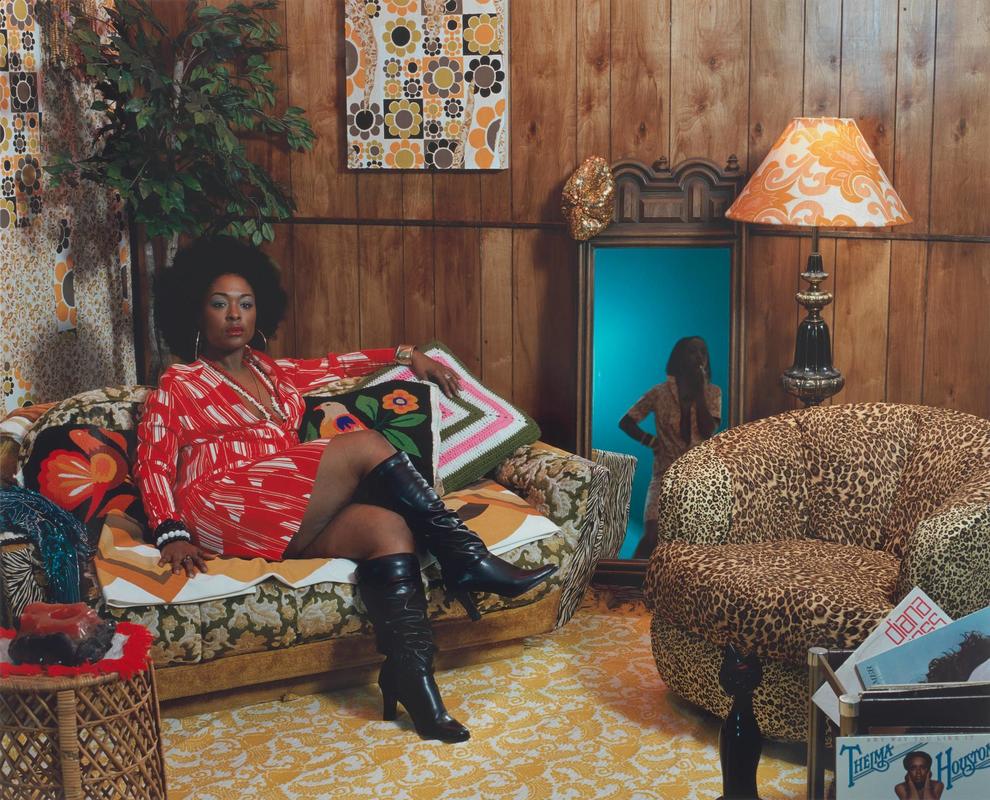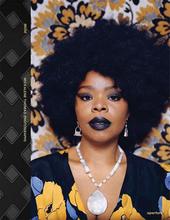More about Sista Sista Lady Blue
- All
- Info
- Shop

Contributor
Mickalene Thomas is known for her decadent, lush work, which is often sparkling and covered in rhinestones.
And all that decadence ain’t for nothing. While Sista Sista Lady Blue is a part of the San Francisco MOMA’s permanent collection, other Thomas pieces have commanded up to seven figures at art auctions. Her work stands out in a crowd and her photography in particular commands attention; it’s vibrant, lively, and compellingly styled—just look at the level of texture on those couch cushions alone. It also often features Black women at the forefront, with Thomas frequently using her lovers as photographic subjects (though this piece features models Tenika and Six Foota.)
While the tokenization of identity can be weird, minimizing, and occasionally serve as a barrier for interesting, meaningful art consumption, Thomas has been open about the impact of her lived experience as a Black queer woman on the art she creates. In an interview with Whoopi Goldberg in 2021, Thomas said “We don’t have the same freedom or privilege as white people to walk around and say, ‘I’m an artist.’ And I welcome that. There was a time when I shied away from it…but I think there’s a power in stating or defining a position. That’s why I continue to make images with Black women at the center.”
These ideas surrounding representation are certainly ones that you can reflect on with this piece; the main figures are both Black women, both in an apparent state of observation and engagement with one another. While the point of focus for Sista, the woman on the couch, is just out of frame, squint and you’ll see the reflection of another woman in the mirror in the photo's background; Thomas has managed to create a relationship between the two of them without actually picturing them in the same plane. This dynamic of subversive, unexpected voyeurism is wonderfully magnetic— and wonderfully queer.
The whole piece invites the presence of female observation-- our observation of the woman on the couch, her observation of the woman in the mirror—but without overly sexualizing either of the women or situating them for a male gaze. Rather, these figures have agency. Sista’s pose seems strong, relaxed and entirely her own - her boots poised, her bracelets on, her hoops in. This takes us far, far away from the trope of naked, languid couch lounging that appears so often throughout art history (you know the ones). Sista doesn’t have time to lay around and eat grapes naked—she’s got records to play and lovers to love. And if she eats grapes on the couch, it will be because she wants to, not because an anonymous viewer wants to observe her doing so.
Sources
- Goldberg, W. (2021, September 9). Mickalene Thomas and Whoopi Goldberg on Artistic Freedom. Interview. https://www.interviewmagazine.com/art/mickalene-thomas-and-whoopi-goldb…
- The Flower Power Era- Fashion in the 60’s. (2019, May 30). Mad Flowers. https://www.madflowers.com/blog/the-flower-power-era-fashion-in-the-60s/
- Community Voices: A Public Dialogue with Tenika aka Lady Blue and Six Foota. (2015, August 15). SF Moma. https://www.sfmoma.org/event/community-voices-a-public-dialogue-with-te…
- Thelma Houston. (2019, February 6). Thelma Houston. https://www.grammy.com/artists/thelma-houston/11879












